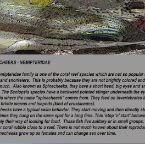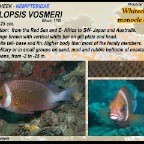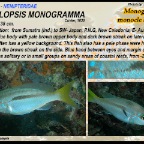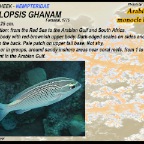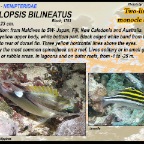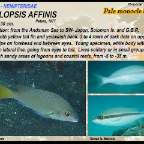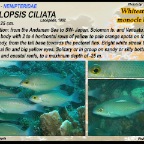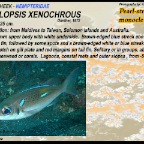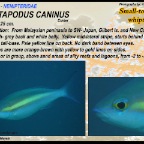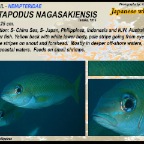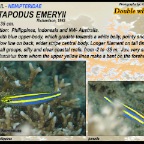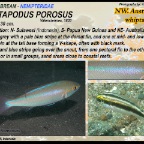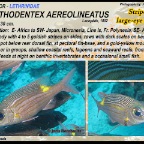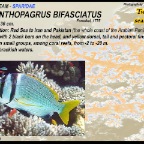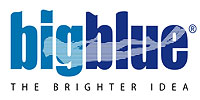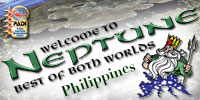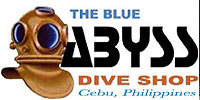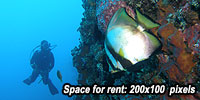Spinecheeks
SPINECHEEKS - NEMIPTERIDAE
The Nemipteridae family is one of the coral reef species which are not so popular by divers and snorkelers. This is probably because they are not brightly colored and don't move much. Also known as Spinecheeks, they have a short head, big eyes and small mouth. The Scolopsis species have a backward pointed stinger underneath the eyes, which is where the name "spinecheeck" comes from. They feed on invertebrates like shells, bristle worms and isopods (kind of crustaceans). Spinecheeks have a typical swim behavior. They start moving and then directly stop. Sometimes they hang on the same spot for a long time. This ‘stop ‘n’ start’ behavior is probably their way of looking for food. These fish live solitary or in small groups, above sand or coral rubble close to a reef. There is not much known about their reproduction. All spinecheeks grow up as females and can change sex over time. Length: 25 cm.
Distribution: from Maldives to Taiwan, Solomon Islands and Australia.
Grey-brown upper body with white underside. Brown-edged blue streak above
pectoral fin, followed by some spots and a brown-edged white or blue streak.
Black blotch on gill plate and red margins on tail fin. Solitary or in groups, above sand, rubble, seaweed or corals. Lagoons, coastal reefs and outer slopes , from -5 to -50 m. Length: 25 cm.
Distribution: from the Red Sea and E- Africa to SW- Japan and Australia.
Red-orange brown with vertical white bar on gill plate and head.
Grey-white tail- base and fin. Higher body than most of the family members.
Lives solitary or in small groups on sand, mud and rubble bottoms of coastal reefs
and lagoons, from -2 to -25 m. Length: 38 cm.
Distribution: from Sumatra (Ind.) to SW- Japan, P.N.G, New Caledonia, E- Australia.
White-blue body with pale brown upper body and dark brown streak on lateral line
which often has a yellow background. This fish also has a pale phase were he does not have the brown streak on the side. Blue band between eyes and margin on yellow tail. Lives solitary or in small groups on sandy areas of coastal reefs, from -2 to -50 m. Length: 25 cm. Distribution: Andaman Sea to Taiwan, SW- Japan, Palau, Vanuatu,N. Australia, G.B.R. Length: 25 cm.
Distribution: from the Red Sea to the Arabian Gulf and South Africa.
Fine lining on the back, not shy. Usually solitary, sometimes in group.
Around sandy inshore areas near coral reefs, from 1 to -20 m.
Abundant in the Arabian Gulf.Length: 25 cm.
Distribution: from the Andaman Sea to SW- Japan, Solomon Is. and Vanuatu.
Greyish body with 2 to 4 horizontal rows of yellow to pale orange spots on the side
of the body, from the tail base towards the pectoral fins. Bright white streak below
the dorsal fin and big yellow eyes. Solitary or in group on sandy or silty bottoms of
lagoons and coastal reefs, to a maximum depth of -25 m. Length: 23 cm.
Distribution: from Maldives to SW- Japan, Fiji, New Caledonia and Australia.
Grey to yellow upper body, white bottom part. Black edged white band from below
the eye to rear of dorsal fin. Three yellow horizontal lines above the eyes.
Propably the most common spinecheek on a reef. Lives solitary or in small groups,
on sand or rubble areas. In lagoons and on outer reefs, from -1 to -25 m. Length: 30 cm.
Distribution: from the Andaman Sea to SW- Japan, Solomon Is. and G.B.R.
Adults with yellow tail fin and yellowish back. 3 to 4 rows of dark dots on upper back. Blue stripe on forehead and between eyes. Young specimen, white body with brown stripe on lateral line, going from eyes to tail. Lives solitary or in small groups on coral-rich sandy areas of lagoons and coastal reefs, from -5 to -35 m. Length: 30 cm.
Distribution: N- Sulawesi (Indonesia), S- Papua New Guinea and NE- Australia.
Pinkish grey with a pale blue stripe at the dorsal fin, and one at mid- and lower body which join at the tail base forming a V-shape, often with black mark.
Orange and blue stripe going over the snout, from one pectoral fin to the other one.
Solitary or in small groups, sand areas close to coastal reefs. Length: 25 cm.
Distribution: S- China Sea, S- Japan, Philippines, Indonesia and N.W. Australia.
A slender fish. Yellow back with white lower body, pale stripe going from eyes to tail. Pale blue stripes on snout and forehead. Mostly in deeper off-shore waters, but often seen in coastal waters. Feeds on small shrimps. Length: 25 cm.
Distribution: from Malaysian peninsula to SW- Japan, Gilbert Is. and New Caledonia. Greenish- grey back and white belly. Yellow mid-lateral stripe, starts behind the eyes towards tail-base. Pale yellow line on back. No dark band between eyes. Juveniles are more orange-brown with yellow to gold lines on sides.
Solitary or in group, above sand areas of silty reefs and lagoons, from -2 to -35 m.


